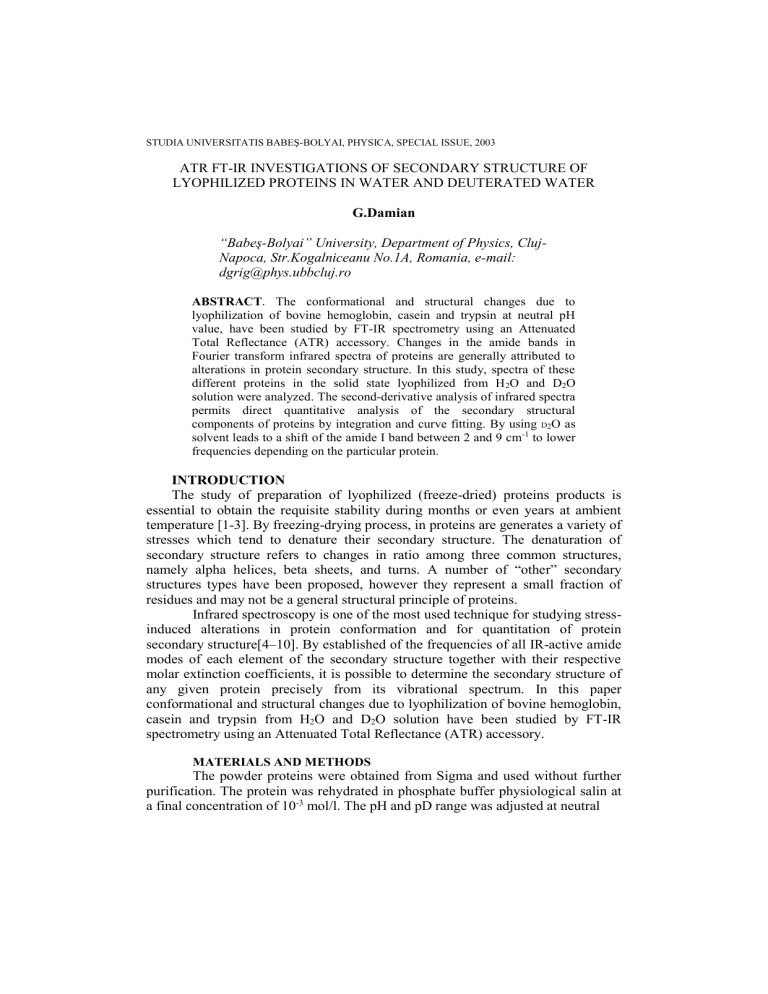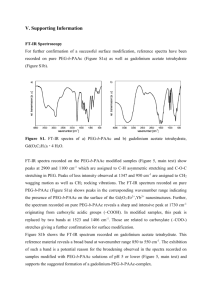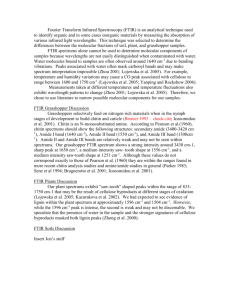“Babeş-Bolyai” University, Department of Physics, Cluj

STUDIA UNIVERSITATIS BABEŞ-BOLYAI, PHYSICA, SPECIAL ISSUE, 2003
ATR FT-IR INVESTIGATIONS OF SECONDARY STRUCTURE OF
LYOPHILIZED PROTEINS IN WATER AND DEUTERATED WATER
G.Damian
“Babeş-Bolyai” University, Department of Physics, Cluj-
Napoca, Str.Kogalniceanu No.1A, Romania, e-mail: dgrig@phys.ubbcluj.ro
ABSTRACT . The conformational and structural changes due to lyophilization of bovine hemoglobin, casein and trypsin at neutral pH value, have been studied by FT-IR spectrometry using an Attenuated
Total Reflectance (ATR) accessory. Changes in the amide bands in
Fourier transform infrared spectra of proteins are generally attributed to alterations in protein secondary structure. In this study, spectra of these different proteins in the solid state lyophilized from H
2
O and D
2
O solution were analyzed. The second-derivative analysis of infrared spectra permits direct quantitative analysis of the secondary structural components of proteins by integration and curve fitting. By using
D2
O as solvent leads to a shift of the amide I band between 2 and 9 cm -1 to lower frequencies depending on the particular protein.
INTRODUCTION
The study of preparation of lyophilized (freeze-dried) proteins products is essential to obtain the requisite stability during months or even years at ambient temperature [1-3]. By freezing-drying process, in proteins are generates a variety of stresses which tend to denature their secondary structure. The denaturation of secondary structure refers to changes in ratio among three common structures, namely alpha helices, beta sheets, and turns. A number of “other” secondary structures types have been proposed, however they represent a small fraction of residues and may not be a general structural principle of proteins.
Infrared spectroscopy is one of the most used technique for studying stressinduced alterations in protein conformation and for quantitation of protein secondary structure[4–10]. By established of the frequencies of all IR-active amide modes of each element of the secondary structure together with their respective molar extinction coefficients, it is possible to determine the secondary structure of any given protein precisely from its vibrational spectrum. In this paper conformational and structural changes due to lyophilization of bovine hemoglobin, casein and trypsin from H
2
O and D
2
O solution have been studied by FT-IR spectrometry using an Attenuated Total Reflectance (ATR) accessory.
MATERIALS AND METHODS
The powder proteins were obtained from Sigma and used without further purification. The protein was rehydrated in phosphate buffer physiological salin at a final concentration of 10 -3 mol/l. The pH and pD range was adjusted at neutral
G. DAMIAN values adding a small amount of NaOH and NaOD respectively. A small amount of
5 ml from each sample was lyophilized for 30 hours at –5 0 C and than used as powder sample.
The FT-IR spectra of proteins were recorded in the region 4000-800 cm -1 by a Bruker EQUINOX 55 spectrometer, using an Attenuated Total Reflectance accessory.with a scanning speed of 32 cm -1 min -1 with the spectral width 2.0 cm -1 .
The internal reflection element was a ZnSe ATR plate (50 x 20 x 2 mm) with an aperture angle of 45°. A total of 128 scans were accumulated for each spectrum.
In the Fourier domain derivative, the second-derivative analysis of infrared spectra permits direct quantitative analysis of the secondary structural components of proteins.By this procedure, the signal to noise ratio of the spectrum is minimized and is amplified the disproportionalety in the weak features of the spectrum. Thus, the areas corresponding to the different types of secondary structure are quantitatively and qualitatively evaluated by integration and curve fitting. The second derivatives of all spectra were calculated using the spectrometer software
OPUS. Before starting the fitting procedure, the obtained depths of the minima in the second derivative spectrum and, subsequently, the calculated maximum intensities were corrected for the interference of all neighboring peaks. The curve fitting is performed by stepwise iterative adjustment towards a minimum rootmean-square error of the different parameters determining the shape and position of the absorption peaks.
RESULTS AND DISSCUTION
Lyophilization induced significant structural alterations in proteins, characterized by a decrease in the α-helix and a significant increase in the
sheet content
The best structural information from infrared band of proteins is the amide I band appearing between 1600 and 1700cm -1 with a maximum for most proteins at around 1654–1674 cm -1 , which arises primarily from the stretch vibration of the peptide C=O group. Normal mode analysis reveals that the C=O stretching couples slightly with CN stretching, CCN deformation and NH bending.
Each type of secondary structure (i.e.
-helix,
-sheet,
-turn and disordered) gives rise to different C=O stretching frequencies [6-10], and, hence, results in characteristic band positions. In the Fourier domain derivative, the secondderivative analysis of infrared spectra permits direct quantitative analysis of the secondary structural components of proteins [6-8]. In figure 1 are presented the inverted second derivative of the lyophilized studied proteins and in the Tables I-
III, its relative areas and assignments of secondary structure. Unfortunately, the
HOH bending motion of water almost coincides with the amide I band and makes studies in protonic aqueous solution difficult [11]. This problem is overcome by using D
2
O as solvent. involved in different secondary structure elements via hydrogen bonding to the peptide NH group, the experimentally observed amide I band envelopes a multitude of single bands with different frequencies which can be resolved as described above.
ATR FT-IR INVESTIGATIONS OF SECONDARY STRUCTURE OF LYOPHILIZED PROTEINS…
1700 1680 1660 1640 1620 1600
1700 1680 1660 1640 1620 1600
1700 1680 1660 1640 1620 1600
Wavenumber (cm
-1
)
Wavenumber (cm
-1
) Wavenumber (cm
-1
)
(a) (b) (c)
Fig.1. Curve-fitted inverted second-derivative amide I spectra of lyophylized (a)hemoglobin,
(b) casein and (c) tripsin from D
2
O (upper) and H
2
O (lower)
Table I
Relative Areas and Assignments of Infrared Second Derivative Amide I Band of lyophilized Bovine Hemoglobin from water and deuterated water.
ν
H
2
O
(cm -1 )
1685
1667
1655
1635
1619
Areas
(%)
17.1
2.6
52.3
9
19.1
D
2
O
ν
(cm -1 )
1674
1661
1651
1633
1616
Areas
(%)
3.2
6
63.1
21.9
6
Assignments turn turn
α-helix
β-sheet
β-sheet
Table II
Relative Areas and Assignments of Infrared Second Derivative Amide I Band of lyophilized Casein from water and deuterated water
ν
(cm -1 )
1683
1676
1668
1652
1644
1637
1626
1613
H
2
O
Areas
(%)
6
9.5
12.1
36.23
4.8
16.9
1.6
12.2
D
2
O
ν
(cm -1 )
1673
1660
1640
1627
1609
Areas
(%)
Assignments
2.8
6.8 turn
9 turn
24.1 turn
57.3 α-helix unordered unordered
β-sheet
β-sheet
G. DAMIAN
Table III
Relative Areas and Assignments of Infrared Second Derivative Amide I Band of lyophilized Trypsin from water and deuterated water
H
2
O
ν
(cm -1 )
1692
1685
1673
Areas
(%)
2.1
17.2
6.8
1663
1653
1645
1634
1610
14.5
10.4
7.3
37.6
4.1
D
2
O
ν
(cm -1 )
1682
1673
1663
1647
1635
1626
Areas
(%)
9.5
9
12.2
20.1
46.4
2.7
Assignments aggregate turn turn
α-helix unordered unordered
β-sheet
β-sheet
CONCLUSIONS
Fourier transform infrared spectroscopy is an important method to determine changes in secondary structure of proteins in the processes, which involve their denaturation. Among the spectral regions arising out of coupled and uncoupled stretching and bending modes of amide bonds, amide I spectral band have the most sensitive to the variations in secondary structure folding.
REFERENCES
[1] J . F . C a r p e n t e r , B . S . C ha n g , Lyophilization of protein pharmaceuticals, in: K.E.
Avis, V.L. Wu (Eds.), Biotechnology and Biopharmaceutical Manufacturing,
Processing and Preservation , Interpharm Press, Buffalo Grove, IL, 1996, pp. 199–
264.
[2] J o l y, M . (1965). A Physico-chemical Approach to the Denaturation of Proteins.
Molecular Biology series Vol. 6. (Eds. Horecker, B., Kaplan, N. O., Scheraga, H. A.),
Academic Press, London
[3] H a r wa l k e r , V . R . a nd K a l a b , M . , Milchwissenschaft. 40(1985); 31-34.
[4] A. D o n g , S . J . P r e s t r e l s ki , S . D . A l l i s o n, J . F . C a r p e n t e r , J. Pharm. Sci.
84
(1995) 415–424.
[5] D . M . B yl e r , H . S u s i , Biopolymers 25 (1986) 469–487.
[6] H . S us i , D . M . B yl e r , Methods Enzymol . 130 (1986) 290– 311.
[7] W . K . S ur e wi c z , H . H . M a nt s c h , Biochim. Biophys. Acta 953 (1988) 115–130.
[8] S . K r i m m, J . B a nd e k a r , Adv. Protein Chem . 38 (1986) 181–364.
[9] A. D o n g , W . S . C a u g h e y , Methods Enzymol . 232 (1994) 139–175.
[10] H . H . M a nt s c h, D . C ha p ma n , Infrared Spectroscopy of Biomolecules , Wiley-
Liss, New York.
[11] K . R a h me l o w K , W . H üb ne r , Appl. Spectrosc . 51(1997), 160-170.







